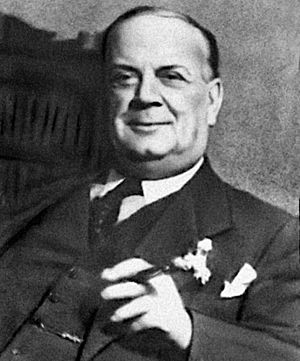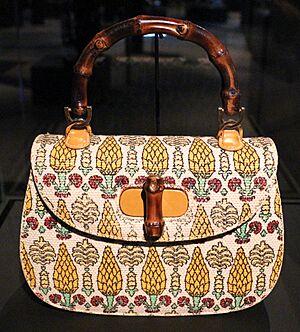Gucci facts for kids
 |
|

Gucci NYC Flagship store
|
|
|
Trade name
|
Gucci |
|---|---|
| Subsidiary | |
| Industry | Fashion |
| Founded | 1921 in Florence, Tuscany, Italy |
| Founder | Guccio Gucci |
| Headquarters |
Via Tornabuoni 73/R,
50123 Florence, Tuscany, Italy |
|
Number of locations
|
529 (2024) |
|
Key people
|
Stefano Cantino (CEO) Demna (creative director) |
| Revenue | €7.65 billion (2024) |
|
Number of employees
|
20,032 (2024) |
| Parent | Kering |
Gucci is a famous Italian fashion company based in Florence. It makes many luxury items like handbags, clothes, shoes, and accessories. Gucci also creates home decorations. The company partners with Coty Inc. to make perfumes and makeup under the name Gucci Beauty.
Gucci was started in 1921 by Guccio Gucci in Florence, Italy. His son, Aldo Gucci, helped make Gucci a well-known brand around the world. It became a symbol of the Italian "sweet life" (dolce vita). After some challenges in the 1980s, the Gucci family was no longer in charge of the company by 1993. The brand then became strong again. In 1999, Gucci joined a big French company called PPR, which is now known as Kering.
In 2024, Gucci had 529 stores and 20,032 employees. It made €7.65 billion in sales. Stefano Cantino became the CEO of Gucci in October 2024. Demna became the creative director in March 2025.
Contents
The Story of Gucci
Starting in Florence in 1921
The Gucci family has roots in Florence, Italy, going back to about 1410. Guccio Gucci (born in 1881) left Florence and worked in Paris. Then, in 1897, he moved to London and worked at the fancy Savoy Hotel. As a bellhop, he helped wealthy guests with their luggage. This taught him a lot about their fashion tastes, quality, and travel needs. He also worked for a luxury train company, learning even more about fancy lifestyles. Before starting his own business, he worked for a company that made fine luggage.
In 1921, Guccio Gucci opened his own shop in Florence. He sold imported leather luggage. He also started a small workshop where local craftspeople made his own leather goods. Soon, he needed a bigger workshop for his sixty workers. In 1935, Italy faced a trade ban, which made leather hard to find. So, Guccio Gucci started using other materials like raffia, wood, and linen for his products. This led to the creation of the "rombi" pattern, which is still a Gucci design today. Gucci also developed a special way to tan leather, called "cuoio grasso," which became a Gucci specialty. In 1937, Gucci launched its first handbags.
Guccio's wife and children all helped in the shop. His son, Aldo Gucci, became very involved in the company from 1925. He convinced his father to open a new shop in Rome in 1938. They also started selling more accessories like gloves, belts, and wallets. During World War II, Gucci workers made boots for the Italian army.
Because materials were scarce during the war, the company made handbags from cotton canvas instead of leather. These canvas bags had a special double-G symbol with red and green stripes. After the war, the Gucci family crest, showing a knight and a ribbon with the family name, became a symbol of Florence.
The Dolce Vita Era After the War
After the war, Guccio Gucci shared parts of the company with his three sons: Aldo, Vasco, and Rodolfo Gucci. In 1947, Gucci launched the Bamboo bag. This bag had light bamboo handles because materials were still hard to find after the war. The company also created its first famous saying: "Quality is remembered long after price is forgotten." In 1952, the well-known Gucci moccasin shoes were launched. Guccio Gucci passed away on January 2, 1953. In November 1953, Gucci opened its first store in the United States, on Fifth Avenue in New York. More New York shops opened later, making that area known as "Gucci City."
In 1961, Gucci opened stores in London and Palm Beach, Florida. They also launched the Jackie Bag. In 1963, Gucci opened its first French store in Paris. The famous double-G logo for belt buckles and other items was introduced in 1964. The Flora scarf was designed in 1966 for Grace Kelly, the Princess of Monaco, who loved Gucci products. In 1968, Gucci opened a store on Rodeo Drive in Hollywood, which led many movie stars to wear the brand. This store also launched Gucci's first dresses. Gucci's success in the US helped it grow worldwide, with stores opening in Tokyo (1972) and Hong Kong (1974). By 1969, Gucci had ten stores in the United States. That year, 84,000 Gucci moccasins were sold in the US alone. US President John F. Kennedy even called Aldo Gucci the "first Italian ambassador to the United States."
Gucci created a Rolls-Royce luggage set in 1970. They also worked with American Motors Corporation (AMC) to make a special Gucci version of the AMC Hornet car from 1971 to 1973. This car was one of the first American cars to offer a luxury design package by a famous fashion designer. Gucci launched its first perfumes and watches in 1972. In 1977, they opened the Gucci Galleria in their Beverly Hills store, a private art gallery for special customers. The prices of Gucci products continued to rise.
In 1985, the Gucci loafer shoe became a permanent part of the collection at the Museum of Modern Art in New York.
Challenges and Changes in the 1980s
In the 1980s, the Gucci family faced some disagreements about how to run the company. To help with these issues, the Gucci group became a public company in 1982, called Guccio Gucci SpA. After his father Rodolfo passed away in 1983, Maurizio Gucci took over the company. In 1988, Maurizio Gucci sold almost half of Gucci to an investment fund called Investcorp.
Even with these challenges, Gucci's sales were strong. However, the 1980s also saw a lot of Gucci products being made, which brought in money but made the brand seem less exclusive. Maurizio Gucci hired Dawn Mello to help bring Gucci back to its high-end status.
From 1991 to 1993, Gucci's finances were still difficult. In 1993, Investcorp bought the rest of Guccio Gucci S.p.A. from Maurizio Gucci, which meant the Gucci family was no longer involved in owning the company.
A New Beginning for Gucci
Dawn Mello joined Gucci in 1989 as a top executive and designer. She worked to make the brand more exclusive again. She reduced the number of stores and the number of different items Gucci sold. She also brought back popular items like the Bamboo bag and the Gucci loafer. She moved Gucci's main office back to Florence, where the company's history began.
Dawn Mello hired Tom Ford to design the women's clothing collection. In 1994, Tom Ford became the creative director of Gucci. Ford and Mello looked back at the brand's designs from the 1970s. Tom Ford's collection in 1995 was very popular.
Domenico De Sole, who was a legal advisor to the Gucci family and became CEO of Gucci in 1994, worked to strengthen relationships with Gucci's leather makers in Italy. He also increased Gucci's advertising budget. In October 1995, the company's shares were listed on the New York Stock Exchange. From 1995 to 1997, Investcorp sold its shares in Gucci.
Big Changes for Gucci
By 1999, a French luxury company called LVMH owned a large part of Gucci. To avoid being taken over by LVMH, Tom Ford and Domenico De Sole sought help from French businessman François Pinault and his group, Pinault Printemps Redoute (now Kering). In March, Pinault's group bought a big share of Gucci. This led to a competition between LVMH and the new Gucci-PPR partnership. The competition ended in September 2001 when all sides reached an agreement. By the end of 2003, Tom Ford and Domenico De Sole announced they would leave Gucci in April 2004.
After Tom Ford left, Gucci Group hired three designers who had worked with him: John Ray, Alessandra Facchinetti, and Frida Giannini. Frida Giannini, who had been a handbag designer for Gucci since 2002, became the creative director of Gucci in 2006. Patrizio di Marco became CEO of Gucci in 2008. Frida Giannini updated classic Gucci designs and created new ones like the New Bamboo and New Jackie handbags. Patrizio di Marco focused on making fewer styles and more mid-range products after the 2008 financial crisis. In 2010, Gucci partnered with Christie's auction house to keep track of the brand's history and confirm product authenticity. In 2011, the company opened the Gucci Museum (Gucci Museo) in Florence to celebrate its 90th anniversary. Between 2010 and 2015, Gucci opened 220 new stores, bringing the total to 500.
A Brand Renaissance

In December 2014, Marco Bizzarri became CEO of Gucci. His job was to help Gucci's sales grow again. In January 2015, Bizzarri chose Alessandro Michele as the creative director of Gucci. Alessandro Michele had worked for Gucci since 2002. In his first fashion show in February 2015, Alessandro Michele showed a "different Gucci" with a "sophisticated, intellectual and androgynous feel."
Alessandro Michele started a "Renaissance" (rebirth) for Gucci. He brought back classic Gucci designs, like the double-G logo and the Jackie O. bag. He also created new popular items like the Dionysus handbag. Alessandro Michele introduced new styles for Gucci, including more feminine menswear and a "geek-chic" look.
In September 2016, Gucci opened its new main office in Milan, called the Gucci Hub. In July 2017, Gucci launched Gucci Décor, its first collection for home decoration. In April 2018, Gucci opened the ArtLab, a large innovation center outside Florence, Italy. Here, new leather goods, shoes, and packaging are developed and tested. In November 2018, Gucci opened the Gucci Wooster Bookstore in New York. In April 2019, the company launched Gucci 9, a network of six call centers worldwide for high-end customer service. Gucci also brought back its makeup collection and launched its first fine jewelry collection. In December 2020, Gucci opened two online stores on Tmall in China. Alessandro Michele left his role as creative director in November 2022.
In January 2023, Sabato de Sarno was named creative director of Gucci. His goal was to make Gucci exciting and valuable again. His first collection introduced a new color, "Gucci Rosso Ancora," a deep burgundy. This collection marked a "new era of practicality" for the brand. During this time, the company also reorganized. In July 2023, Jean-François Palus took over as CEO of Gucci to lead this change. Sales decreased slightly in 2023. In October 2024, Stefano Cantino became CEO. De Sarno left Gucci in February 2025 and Demna Gvasalia replaced him the next month.
About Gucci
Gucci's main company, Guccio Gucci S.p.A., is located in Florence, Italy. It is part of the French luxury group Kering. In 2024, Gucci had 529 stores and 20,032 employees. It made €7.65 billion in sales.
Leadership at Gucci
For a long time, members of the Gucci family managed the design, promotion, and making of Gucci products.
CEOs of Gucci
- Since 2024: Stefano Cantino
- 2023–2024: Jean-François Palus
- 2014–2023: Marco Bizzarri
- 2008–2014: Patrizio di Marco
- 2004–2008: Mark Lee
- 1994–2004: Domenico De Sole
Creative Directors of Gucci
- Since 2025: Demna Gvasalia
- 2023-2025: Sabato De Sarno
- 2015–2022: Alessandro Michele
- 2006–2015: Frida Giannini
- 1995–2004: Tom Ford
- 1989–1995: Dawn Mello
Gucci's Financial Performance
| Year | Revenue (billion €) |
|---|---|
| 2019 | 9.63 |
| 2020 | 7.4 |
| 2021 | 9.7 |
| 2022 | 10.5 |
| 2023 | 9.9 |
| 2024 | 7.65 |
Gucci's Special Projects
Culture and Arts
In 2011, Gucci opened the Gucci Museum (Gucci Museo) in Florence to celebrate its 90th birthday. In 2018, the museum reopened as the Gucci Garden and included a restaurant called the Gucci Osteria. This restaurant earned a Michelin star in 2019. Another Gucci Osteria opened in Los Angeles in 2020. In 2022, Gucci opened a cocktail bar in Florence called the Gucci Giardino 25.
Gucci has also helped restore important historical sites. In 2017, they helped restore the Boboli Gardens in Florence. In 2019, they helped restore the Rupe Tarpea and Belvedere Gardens in Rome. In 2022, Gucci promised to help restore and protect the Gyeongbokgung Palace in South Korea.
Social Causes
In 2008, Gucci started the Gucci Tribeca Documentary Fund. This fund gives money to movies that promote social change. In 2011, Gucci also started the 'Gucci Award for Women in Cinema' to recognize the important work of women in filmmaking.
From 2005 to 2015, Gucci gave $20 million to UNICEF's Schools for Africa program. In 2013, Frida Giannini, Salma Hayek, and Beyoncé founded Chime for Change. This is a worldwide campaign to improve education, health, and justice for women. In 2013, Chime for Change held a concert that raised $4 million for projects in 70 countries.
Gucci sells a yellow t-shirt that says "My Body My Choice" and gives the money from sales to Chime for Change. In 2019, Chime for Change launched a mural campaign called "To Gather Together" to promote gender equality. In 2020, Gucci featured a model with Down syndrome in an "Unconventional Beauty" ad campaign.
During the COVID-19 pandemic, Gucci donated €2 million to help with relief efforts in Italy and for the COVID-19 Solidarity Response Fund. In 2023, Gucci gave another 300,000 euros to UNICEF to support children's right to good education worldwide.
Caring for the Environment
In 2015, Gucci started its own plan to measure its environmental impact.
In October 2017, Gucci announced that it would stop using real fur in its products starting in 2018.
In June 2018, the brand launched 'Equilibrium', an online platform to share its efforts and progress in social and environmental areas.
In June 2020, Gucci launched its first fully sustainable collection called "Gucci Off the Grid." This collection included items made from organic, natural, and recycled materials.
In September 2022, Gucci received an award for its dedication to environmental sustainability. In 2023, Gucci won an award for its work in the circular economy, which focuses on reusing and recycling materials.
In February 2023, Gucci announced the creation of the Circular Hub. This new manufacturing center is designed to be very efficient and reduce carbon emissions.
In October 2023, Gucci introduced the Horsebit 1955 bag made with Demetra, a material that is not from animals. This bag won an award for being the best vegan bag from PETA.
Fighting Fake Products
In the 1970s, Gucci became very popular, which also made it a target for people making fake products. Gucci developed special tanning techniques that were hard for counterfeiters to copy. In 1977 alone, Gucci filed 34 lawsuits against people selling fakes. By the mid-1980s, the brand was involved in "thousands of lawsuits all over the world" to stop fake products.
In 2013, a ruling in the UK said Gucci had lost some rights to its GG logo in certain product categories. However, Gucci stated that this did not affect its overall use of the GG logo, as it has other valid registrations for the mark across Europe.
In 2008, a website selling fake Gucci products was shut down after Gucci sued it. In 2013, Gucci took action against 155 website names used by counterfeiters. In 2015, Gucci's parent company Kering sued the Chinese website Alibaba for listing many "obviously fake Gucci products." In 2017, Gucci won a lawsuit against 89 Chinese websites selling fake products. In 2018, Marco Bizzarri warned Chinese e-commerce companies Alibaba and JD.com that Gucci would not open stores on their sites unless they removed the many fake Gucci products. In 2019, Gucci sued many websites selling fake products. In 2023, Gucci USA filed lawsuits against Sam's Club, Century 21, and Lord & Taylor for selling fake Gucci items.
See also
 In Spanish: Gucci para niños
In Spanish: Gucci para niños
- Made in Italy
- Prada
- ZEGNA
- Moncler




